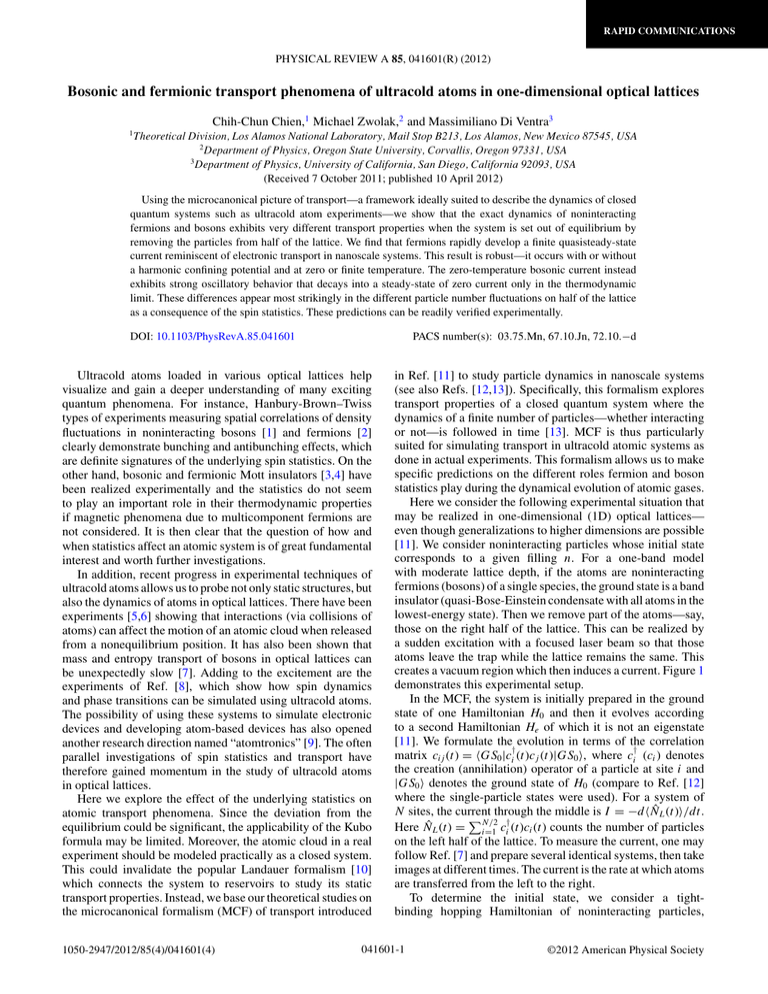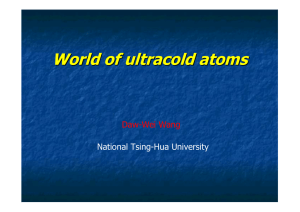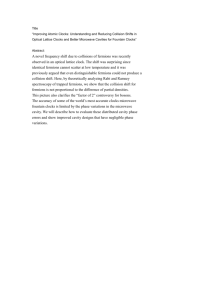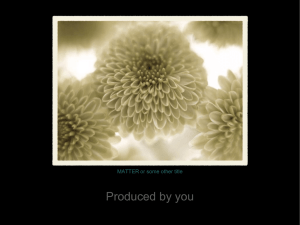Bosonic and fermionic transport phenomena of ultracold atoms in one-dimensional... Chih-Chun Chien, Michael Zwolak, and Massimiliano Di Ventra
advertisement

RAPID COMMUNICATIONS
PHYSICAL REVIEW A 85, 041601(R) (2012)
Bosonic and fermionic transport phenomena of ultracold atoms in one-dimensional optical lattices
Chih-Chun Chien,1 Michael Zwolak,2 and Massimiliano Di Ventra3
1
Theoretical Division, Los Alamos National Laboratory, Mail Stop B213, Los Alamos, New Mexico 87545, USA
2
Department of Physics, Oregon State University, Corvallis, Oregon 97331, USA
3
Department of Physics, University of California, San Diego, California 92093, USA
(Received 7 October 2011; published 10 April 2012)
Using the microcanonical picture of transport—a framework ideally suited to describe the dynamics of closed
quantum systems such as ultracold atom experiments—we show that the exact dynamics of noninteracting
fermions and bosons exhibits very different transport properties when the system is set out of equilibrium by
removing the particles from half of the lattice. We find that fermions rapidly develop a finite quasisteady-state
current reminiscent of electronic transport in nanoscale systems. This result is robust—it occurs with or without
a harmonic confining potential and at zero or finite temperature. The zero-temperature bosonic current instead
exhibits strong oscillatory behavior that decays into a steady-state of zero current only in the thermodynamic
limit. These differences appear most strikingly in the different particle number fluctuations on half of the lattice
as a consequence of the spin statistics. These predictions can be readily verified experimentally.
DOI: 10.1103/PhysRevA.85.041601
PACS number(s): 03.75.Mn, 67.10.Jn, 72.10.−d
Ultracold atoms loaded in various optical lattices help
visualize and gain a deeper understanding of many exciting
quantum phenomena. For instance, Hanbury-Brown–Twiss
types of experiments measuring spatial correlations of density
fluctuations in noninteracting bosons [1] and fermions [2]
clearly demonstrate bunching and antibunching effects, which
are definite signatures of the underlying spin statistics. On the
other hand, bosonic and fermionic Mott insulators [3,4] have
been realized experimentally and the statistics do not seem
to play an important role in their thermodynamic properties
if magnetic phenomena due to multicomponent fermions are
not considered. It is then clear that the question of how and
when statistics affect an atomic system is of great fundamental
interest and worth further investigations.
In addition, recent progress in experimental techniques of
ultracold atoms allows us to probe not only static structures, but
also the dynamics of atoms in optical lattices. There have been
experiments [5,6] showing that interactions (via collisions of
atoms) can affect the motion of an atomic cloud when released
from a nonequilibrium position. It has also been shown that
mass and entropy transport of bosons in optical lattices can
be unexpectedly slow [7]. Adding to the excitement are the
experiments of Ref. [8], which show how spin dynamics
and phase transitions can be simulated using ultracold atoms.
The possibility of using these systems to simulate electronic
devices and developing atom-based devices has also opened
another research direction named “atomtronics” [9]. The often
parallel investigations of spin statistics and transport have
therefore gained momentum in the study of ultracold atoms
in optical lattices.
Here we explore the effect of the underlying statistics on
atomic transport phenomena. Since the deviation from the
equilibrium could be significant, the applicability of the Kubo
formula may be limited. Moreover, the atomic cloud in a real
experiment should be modeled practically as a closed system.
This could invalidate the popular Landauer formalism [10]
which connects the system to reservoirs to study its static
transport properties. Instead, we base our theoretical studies on
the microcanonical formalism (MCF) of transport introduced
1050-2947/2012/85(4)/041601(4)
in Ref. [11] to study particle dynamics in nanoscale systems
(see also Refs. [12,13]). Specifically, this formalism explores
transport properties of a closed quantum system where the
dynamics of a finite number of particles—whether interacting
or not—is followed in time [13]. MCF is thus particularly
suited for simulating transport in ultracold atomic systems as
done in actual experiments. This formalism allows us to make
specific predictions on the different roles fermion and boson
statistics play during the dynamical evolution of atomic gases.
Here we consider the following experimental situation that
may be realized in one-dimensional (1D) optical lattices—
even though generalizations to higher dimensions are possible
[11]. We consider noninteracting particles whose initial state
corresponds to a given filling n. For a one-band model
with moderate lattice depth, if the atoms are noninteracting
fermions (bosons) of a single species, the ground state is a band
insulator (quasi-Bose-Einstein condensate with all atoms in the
lowest-energy state). Then we remove part of the atoms—say,
those on the right half of the lattice. This can be realized by
a sudden excitation with a focused laser beam so that those
atoms leave the trap while the lattice remains the same. This
creates a vacuum region which then induces a current. Figure 1
demonstrates this experimental setup.
In the MCF, the system is initially prepared in the ground
state of one Hamiltonian H0 and then it evolves according
to a second Hamiltonian He of which it is not an eigenstate
[11]. We formulate the evolution in terms of the correlation
†
†
matrix cij (t) = GS0 |ci (t)cj (t)|GS0 , where ci (ci ) denotes
the creation (annihilation) operator of a particle at site i and
|GS0 denotes the ground state of H0 (compare to Ref. [12]
where the single-particle states were used). For a system of
N sites, the current through the middle is I = −dN̂L (t)/dt.
N/2 †
Here N̂L (t) = i=1 ci (t)ci (t) counts the number of particles
on the left half of the lattice. To measure the current, one may
follow Ref. [7] and prepare several identical systems, then take
images at different times. The current is the rate at which atoms
are transferred from the left to the right.
To determine the initial state, we consider a tightbinding hopping Hamiltonian of noninteracting particles,
041601-1
©2012 American Physical Society
RAPID COMMUNICATIONS
CHIEN, ZWOLAK, AND DI VENTRA
PHYSICAL REVIEW A 85, 041601(R) (2012)
t<0
(f,n=1)
I (1/t0 )
0.6
(f,n=0.75)
0.3
(f,n=0.5)
0
I(1/t0 )
t>0
0.2
0.1
0
-0.1
(f,n=0.25)
(b,n=1)
0
N=512
100
I (1/t0 )
FIG. 1. Schematic plot of the setup for fermions that we simulate.
The gray dots emphasize that atoms may be in a superposition of
locations.
†
†
H0 = −t˜ ij ci cj + j (1/2)mω2 d 2 (j − N/2−1/2)2 cj cj ,
on a finite, nonperiodic lattice. Here, t˜ is the hopping
coefficient and it determines the unit of time, t0 ≡ h̄/t˜,
and m, ω, d are the mass of atoms, the trap frequency of
a background harmonic potential, and the lattice constant,
respectively. We define Y ≡ mω2 d 2 /t˜ with Y ∼ 0.001
as in Refs. [5,6]. For fermions of one species, s-wave
scattering and the Pauli exclusion principle naturally forbid
observable interactions among atoms. For bosons we assume
the background scattering is negligible. We remark that no
dissipation mechanism is considered in our study, which is
consistent with Refs. [5,6].
The system is filled up to the given filling factor n
and the ground state is best described in the energy basis
†
with the creation (annihilation) operator bk (bk ). Here the
index k labels different energy eigenvalues and should not
be confused
with the momentum. The unitary transformation cj = k (U )j k bk diagonalizes the Hamiltonian as Hh =
N
†
Y = 0, one has k = −2t˜ cos[kπ/(N +
k=1 k bk bk . When
j kπ
2
1)] and Uj k = N+1
sin( N+1
) with j,k = 1, . . . ,N. For t < 0
the correlation function for N particles at zero temperature
†
†
(T = 0) is bk bk = δkk for fermions and bk bk = N δkk δk1
for bosons, where k = 1 denotes the lowest-energy state. For
fermions of one species, at n = 1 the lowest band is completely
filled, thus there are no spatial correlations for fermions
due to the Pauli exclusion principle, but there are ample
spatial correlations for bosons. At finite T or other filling,
†
bk bk = nk δkk , where nk = {exp[(k − μ)/kB T ] ± 1}−1 is
the corresponding thermal distribution and μ is the chemical
potential. We set kB ≡ 1.
The correlation matrix in real space can be written down us
†
ing the unitary transformation as cij = k,k (U † )ki bk bk Uj k .
In Fig. 2(c) we show the density profile of the ground state with
n = 0.5 initially and Y = 0.001 at T = 0, which resembles
the wedding-cake structure of bosonic Mott insulators [7]. At
t = 0 all atoms on the right half are blown off by a laser beam
whose frequency is different from that of the laser generating
the optical lattices, so that the lattice remains intact. The
consequence is that cij (t = 0) becomes zero if i or j is on the
(c)
b,N=8192
0
t/t0
0
4000
0
T=0
0.6
0
T=0
Y=0.01
(d)
Y=0.01
T=0
-0.3
-0.6
512
i
Y=0.001
T/t =4
T/t =8
0.3
300
1
(b)
0.9
I
200
t/t0
ni
-0.3
t=0
(a)
(f,n=0.5)
25
0
t/t0
50
75
FIG. 2. (Color online) (a) Currents in a uniform lattice for
fermions (top) and bosons (bottom) with initial n = 1 at T = 0 after
the atoms on the right are removed. The fermionic currents for initial
fillings n = 0.75, 0.5, 0.25 are also shown (labeled next to each curve).
Here N = 512. (b) The bosonic current for N = 8192 with initial
filling n = 1. (c) The density profile for fermions with N = 512,
n = 0.5, and Y = 0.001 at T = 0. (d) Fermionic currents in a lattice
with a harmonic potential for n = 0.5 and N = 512. The solid lines
correspond to T /t˜ = 0, 4, 8 with Y = 0.001, while the dashed line
corresponds to T /t˜ = 0 with Y = 0.01. Here Y = mω2 d 2 /t˜.
right half, but the submatrix of the left half (both i,j N/2)
is not affected.
The evolution of cij is determined by
cij (t) =
N
(U † )ki (U )j k Dkk (0)ei(k −k )t .
(1)
k,k =1
N/2
Here Dkk (0) = i,j =1 (U † )k j Uik cij (t = 0) is the initial correlation matrix in the energy basis after the atoms on the right
half are removed. The current from the left to the right is then
†
I = −2t˜ ImcN/2 (t)cN/2+1 (t).
(2)
Although bosons and fermions obey different statistics, the
expression for the respective current is the same. The behavior
of the current, however, is qualitatively different.
Figure 2(a) shows the currents of fermions and bosons
on a uniform lattice of N = 512 with initial n = 1 at T = 0
after the atoms on the right half are removed. The fermionic
current reaches a plateau after a short initial transient time.
This constant current has a duration proportional to the system
size, indicating that fermions will develop a true steady state of
finite current in the thermodynamic limit. For the finite-system
case, the current varies abruptly when the electrons traveling
to the right reach the far boundary and come back, as is seen
in Fig. 2(a). Here we will focus on the physics prior to this
finite-size revival behavior. The almost constant current found
here is similar to the quasisteady-state current (QSSC) shown
041601-2
RAPID COMMUNICATIONS
BOSONIC AND FERMIONIC TRANSPORT PHENOMENA OF . . .
(3)
2
Nbosons
=
N/2
|cij |2 ,
(5)
|cij |2 .
(6)
i<j
N/2
ni (1 + ni ) + 2
i<j
i=1
In contrast to the current, the expressions for the fluctuations
are different for fermions and bosons. In the following we
focus on T = 0.
For fermions, 0 ni ,|cij | 1 due to the Pauli exclusion
principle. Clearly, the correlation terms |cij |2 reduce the
number fluctuations. For the initial filling n = 1, right after the
particles on the right half lattice are removed, the instantaneous
number fluctuations on the left half are zero because the Pauli
exclusion principle forces one particle per site. In contrast, the
0
(a)
(b)
0
0.4
0
-2000
2
0.8
2
2
ΔN -ΔN (0)
2
1.2
2
Therefore, in the thermodynamic limit, the long-time current
decays to zero for bosons. This analysis is supported by our
simulations shown in Figs. 2(a) and 2(b).
Another interesting question is how the filling factor affects
the QSSC for fermions. If one performs the experiments
separately for different initial filling factors n = 1, 0.75, 0.5,
and 0.25 on a uniform lattice using fermions, the QSSC does
not exhibit linear dependence on n, as shown in Fig. 2(a).
This nonlinear dependence of the QSSC versus the filling
factor originates from the band structure, which results in
differing amounts of correlations between sites on the lattice.
As the filling gets lower, the initially remaining fermions on
the left half lattice are more correlated because the constraint
from the Pauli exclusion principle is less restrictive. This
correlation effect competes with the counting of contributions
from different energy states. However, the initial filling does
ni (1 − ni ) − 2
i=1
N/2
ΔN -ΔN (0)
In the final expression only terms with {p = 1,p = even}
and {p = 1,p = even} contribute and their contributions are
equal. We focus on the long-time limit and set t = (N/2)t0 .
One can make other choices as long as t/t0 ∼ O(N/2) and
obtain the same conclusions. We consider {p = 1,p = even}
and the final result is simply twice the current of this part. Due
to the rapid oscillatory√part of the first term for large t/t0 , only
0 < p /(N + 1) < 1/ N may contribute finitely. The current
then approaches
1
p̄π 1
−t˜ √N
∝ N −1/2 .
d p̄ sin[N (1− cos(p̄π ))] sin
I→
p̄
2π 0
2
N/2
2
=
Nfermions
2
× UN/2,p UN/2+1,p N F (p)F (p ).
not affect the qualitative behavior of the QSSC of fermions if
it is not too different from n = 1.
Before discussing other differences of the two dynamics,
let us first check if they can be observed experimentally.
For optical lattices with moderate depth, with V0 and ER
the lattice depth and recoil energy, respectively, a typical
magnitude of the hopping parameter t˜ can be estimated from
the parameters given in Ref. [16]. For V0 /ER = 10, t˜ ≈ 3 nK,
which corresponds to t0 = 2.5 ms. Therefore the oscillations
of the bosonic current are not too difficult to detect. Moreover,
the typical holding time for recent experiments can be of the
order of 1 s [5], so the QSSC of fermions, which is of the order
of about 50t0 ∼ 0.13 s for a lattice of N = 512 sites with a
reasonable harmonic potential, should also be observable for
T 8t˜, according to Fig. 2(d).
We now show that particle number fluctuations can
distinguish the underlying spin statistics when the system
is dynamically evolving. Let us evaluate the instantaneous
fluctuations in the total number of particles on the left half
lattice, N 2 . Experimentally N 2 may be measured by
repeating the preparation and measurement at a given time
so the fluctuations could be inferred. By definition,
(4)
N 2 = N̂L2 − N̂L 2 .
N/2
N/2
†
Here N̂L2 = i=1 n̂2i + 2 i<j n̂i n̂j , where n̂i = ci ci
and ni = n̂i . This expression involves expectation values of
four operators and one can decompose them using Wick’s
theorem. The decomposition, however, is sensitive to the
underlying spin statistics. After some algebra, one has
ΔN -ΔN (0)
in Ref. [12], where a step-function bias is applied to a half-filled
lattice. As in that case, it shows that a quasisteady state can
originate dynamically in the absence of interactions, solely due
to the wave properties of the system [11]. Moreover, QSSCs
can develop in higher-dimensional geometries, as shown in
Ref. [12].
Importantly, the fermionic QSSC is observable in the
presence of a reasonable harmonic trap potential for both
T = 0 and finite T [14], as shown in Fig. 2(d). We note
that the length of the initial transient time during which
the current oscillates significantly depends on the initial-state
configuration and how the system is set out of equilibrium.
In contrast, the T = 0 bosonic current exhibits rapid
oscillations with a period ∼t0 (I /Iavg 1, where I is the
amplitude of the oscillations and Iavg is the current averaged
over a period of time). Therefore, a QSSC is not found [15].
However, as it is also evident from Figs. 2(a) and 2(b) that
the oscillations of the bosonic current decrease with time.
For bosons with initial filling n = 1 on a uniform lattice of
size N , the correlation matrix in the energy basis after the
atoms
on the right half lattice are removed is Dkk (t = 0) =
N i,j N/2 Ui1 Uj i Uik Uj k at T = 0. In the limit N → ∞ it
approaches NF (p)F (p ), where F (p) = p cos(pπ/2)/[(1 −
p2 )π ]. F (p = odd) = 0, except F (1) = 1/4 and F (p = even)
is finite.
The current from Eq. (2) then becomes
pπ
pπ
− cos
sin 2t˜t cos
I = 2t˜
N +1
N +1
p
=p
PHYSICAL REVIEW A 85, 041601(R) (2012)
-400
-4000
-6000
fermions
0
100
200
t/t0
300
0
t/t0
300
bosons
0
100
200
300
t/t0
FIG. 3. Particle number fluctuations on the left half lattice for
(a) fermions and (b) bosons in a uniform lattice. Here n = 1 before
the particles on the right half are removed and N = 512. The inset
shows the bosonic fluctuations of a hypothetical case where the initial
configuration is identical to that of the fermions.
041601-3
RAPID COMMUNICATIONS
CHIEN, ZWOLAK, AND DI VENTRA
PHYSICAL REVIEW A 85, 041601(R) (2012)
initial boson distribution does not have this constraint. Thus,
by removing particles on the right half lattice, one removes half
of the total number of particles on average so initial number
fluctuations are present. Moreover, |cij |2 contributes positively
to the fluctuations of bosons.
To better visualize these results we plot in Fig. 3 the
quantity N 2 (t) − N 2 (t = 0) for fermions and bosons in a
uniform lattice. For fermions the fluctuations increase slowly
after an initial transient time. This slow change in fluctuations
corresponds to the QSSC in Fig. 2(a). The behavior for bosons
is very different. The contribution from the spatial correlation |cij |2 decreases with time so the fluctuations decrease
accordingly. The initial state of bosons is a quasicondensate,
so there is strong coherence among particles on different
sites. As the system evolves and more particles move to
the right, the coherence decreases rapidly so the number
fluctuations are reduced when compared to the initial number
fluctuations. Since there are about N 2 terms in the contribution
from spatial correlations, the observed change in N 2 for
bosons is several orders of magnitude larger than that for the
fermions.
There are important differences when comparing our results
with the Hanbury-Brown–Twiss type of experiments [1,2],
where spatial correlations of density fluctuations are measured.
While those experiments [1,2] utilize the underlying spin
statistics for an equilibrium system but implement a dynamical
measurement (time-of-flight imaging), our discussion depends
on the statistics of the initial distribution as well as the
corresponding quantum dynamics. Thus the difference in N 2
demonstrated here is a dynamic property.
To further stress this point, we consider a hypothetical case
for bosons where the initial configuration is assumed to be
exactly the same as that of fermions, i.e., the lowest N energy
states for n = 1 are occupied by one boson each before the
particles on the right half are removed. Due to this selected
initial correlation matrix, the bosonic current will be exactly
the same as the fermionic current shown in Fig. 2(a) and will
show a QSSC. However, the bosonic number fluctuations, as
shown in the inset of Fig. 3(b), are very different from the
fermionic ones shown on Fig. 3(a), so the underlying statistics
can still be resolved.
We conclude that nonequilibrium dynamics of noninteracting atomic gases already demonstrates unexpected phenomena. Ultracold atoms in optical lattices have the great potential
of demonstrating a QSSC and its dependence on the spin
statistics in noninteracting clean systems, which is difficult
to realize for electronic systems due to Coulomb interactions.
Since interactions between atoms are experimentally tunable,
we anticipate that transport phenomena in the presence of interactions will also reveal interesting physics [17,18]. The setup
discussed here could also be of interest to the community of
quench dynamics [19]. Therefore the microcanonical picture
of transport presented here could contribute significantly to
our understanding of many fundamental aspects of transport
phenomena in ultracold atoms.
[1] S. Folling, F. Gerbier, A. Widera, O. Mandel, T. Gericke, and
I. Bloch, Nature (London) 434, 481 (2005).
[2] T. Rom, T. Best, D. van Oosten, U. Schneider, S. Folling,
B. Paredes, and I. Bloch, Nature (London) 444, 733 (2006).
[3] M. Greiner, O. Mandel, T. Esslinger, T. W. Hansch, and I. Bloch,
Nature (London) 415, 39 (2002).
[4] R. Jordens, N. Strohmaier, K. Gunter, H. Moritz, and
T. Esslinger, Nature (London) 455, 204 (2008).
[5] H. Ott, E. de Mirandes, F. Ferlaino, G. Roati, G. Modugno, and
M. Inguscio, Phys. Rev. Lett. 92, 160601 (2004).
[6] N. Strohmaier, Y. Takasu, K. Gunter, R. Jordens, M. Kohl,
H. Moritz, and T. Esslinger, Phys. Rev. Lett. 99, 220601 (2007).
[7] C. L. Hung, X. Zhang, N. Gemelke, and C. Chin, Phys. Rev.
Lett. 104, 160403 (2010).
[8] J. Simon, W. S. Bakr, R. Ma, M. E. Tai, P. M. Preiss, and
M. Greiner, Nature (London) 472, 307 (2011).
[9] R. A. Pepino, J. Cooper, D. Z. Anderson, and M. J. Holland,
Phys. Rev. Lett. 103, 140405 (2009).
[10] R. Landauer, IBM J. Res. Dev. 1, 223 (1957).
[11] M. Di Ventra and T. Todorov, J. Phys.: Condens. Matter 16, 8025
(2004).
[12] N. Bushong, N. Sai, and M. Di Ventra, Nano Lett. 5, 2569
(2005).
[13] M. Di Ventra, Electrical Transport in Nanoscale Systems
(Cambridge University Press, Cambridge, UK, 2008).
[14] At finite T , μ is determined by n = k nk /N for the initial
state. Moreover, while the QSSC still occurs at higher T in our
model, experiments would need to be done at moderately low T
in order to retain atoms in the lowest-energy band.
[15] As T increases, the initial boson distribution spreads and a QSSC
can survive at high T .
[16] T. L. Ho and Q. Zhou, Phys. Rev. Lett. 99, 120404 (2007).
[17] J. Kajala, F. Massel, and P. Torma, Phys. Rev. Lett. 106, 206401
(2011).
[18] C. C. Chien, M. Di Ventra, and M. Zwolak, e-print
arXiv:1203.5094 (2012).
[19] A. Polkovnikov, K. Sengupta, A. Silva, and M. Vengalattore,
Rev. Mod. Phys. 83, 863 (2011).
We thank B. DeMarco for useful discussions. C.C.C.
acknowledges the support of the US DOE through the
LANL/LDRD Program. M.D. acknowledges support from
DOE Grant No. DE-FG02-05ER46204 and UC Laboratories.
041601-4





